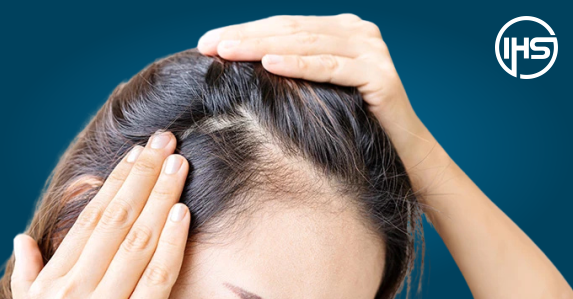



Contact our specialists now for Hair Replacement!
Did you know that about 90% of your hair stays in the growing phase during pregnancy?
Postpartum hair loss refers to losing hair from your scalp, and sometimes even your eyebrows and eyelashes, after you’ve had your little one.
Motherhood is brilliant, but it does bring changes, doesn’t it? According to biology, when a woman is pregnant, the estrogen levels go up, which keeps your hair in the growth phase for a longer time, making your hair look thicker. After giving birth, these estrogen levels drop, and your hair growth returns to normal.
Now, what can we do about it? Here’s some good news: It usually settles down on its own.
But on the other side of it, if you feel that the hair loss is excessive, then you must consider non-surgical hair replacement options such as hair systems that can offer you immediate coverage.
In a study, 19.7% of women took remedial action to address their hair loss during postpartum, which may include options such as wigs.
Remember, you’re not alone, and this phase is temporary.
If you start shedding hair after your pregnancy ends, it’s known as post-pregnancy hair loss, also called postpartum alopecia.
It’s a widespread issue for women who have just given birth as the oestrogen levels they enjoyed during pregnancy (think glowing skin, strengthened nails and, yes, terrific, thick hair) start to drop.
This sudden oestrogen drop causes more hairs to enter the ‘shedding phase’ as the body readdresses the hormone imbalance. The result is noticeable thin hair, usually starting around 2-4 months after you have your baby.
The birth of your child is undoubtedly one of the most exciting moments of your life. But at the same time, pregnancy does come with physiological changes, mainly due to fluctuating hormone levels.
Here are the hormonal changes during pregnancy and postpartum :
1 ) Progesterone and estrogen: These hormones decrease as soon as the baby and the placenta are delivered.
2 ) Oxytocin: Surges immediately following birth to compensate for the initial drops in progesterone and estrogen. This hormone is responsible for that strong parenting instinct. However, you’ll probably still experience some “baby blues” in the first few days postpartum as the oxytocin works itself out of your system.
3 ) Prolactin: Increases to encourage milk production. (If you are not nursing, prolactin drops to pre-pregnancy levels within a few weeks.)
Postpartum hair loss mainly happens because of hormonal changes, such as estrogen, during and after pregnancy.
When a woman is pregnant, higher estrogen levels extend the growth cycle for hair, making hair grow longer and thicker.
After pregnancy, hormones go back to their normal levels. This causes a lot of hair in the growing cycle to enter the shedding phase simultaneously.
Here are the other causes of hair loss :
Postpartum “shedding” doesn’t happen immediately after your baby is born also, it is very common in women.
In fact, this noticeable hair loss can come as a surprise after most other postpartum symptoms have passed, with peak hair loss around four to five months postpartum.
And if it happens to you, you’re not alone. About half of all new mamas experience this condition.
1 ) 2 to 3 months postpartum : Most women will not notice hair shedding in the first couple of months after delivering their baby. However, the hormonal changes have shifted many scalp hairs into the resting phase to prepare for shedding.
2 ) 3 to 5 months postpartum : This is when most women will begin to observe noticeably more hairs falling out during brushing, washing, or styling.
3 ) 6 to 12 months postpartum : The shedding phase continues through these months for most women. The shedding will slow down gradually toward the latter end of this timeframe.
1 ) Get a new haircut : This can be the best treatment for postpartum hair loss, and that is to get a new/ fresh haircut, as this could give you the perfect excuse to change up your usual hairstyle. Together, you and your hairdresser can decide on the best new hairdo to suit you. Popular styles include bangs, pixie cuts and the lob (that’s a long bob)
2 ) Try a wig/hair patches : A women’s wig is a practical hair loss solution that covers hair loss instantly (applies when you have severe hair loss). You can choose one that looks like your usual hair- or you could get creative and opt for a completely new style. Hair patches could conceal thin areas if a full wig isn’t needed.
1 ) Take proper nutrients : Keep your hair healthy by eating well and continuing to take your prenatal vitamin supplement.
2 ) Show some love to your hair : Be extra gentle to prevent excess hair loss after pregnancy. Shampoo only when necessary, and use a good conditioner and a wide-toothed comb to minimise tangling.
3 ) Choose the right accessories : We know post-pregnancy hair issues are hard to handle. Use scrunchies to put hair up instead of elastic bands and don’t pull hair into tight ponytails.
4 ) Turn down the heat : Skip blow-dryers, curling and flat irons if you can.
5 ) Say no to chemical-based treatments : Preventing hair loss after childbirth do ask for treatments (without chemicals). So, try not to put off any highlights, perms and straightening sessions until the shedding stops.
Postpartum hair loss is a natural process that happens to many new moms about 3 months after giving birth.
While your hair grows back on its own within a year, we understand you want to feel like yourself again sooner. That’s why at IHS London we offer non-surgical hair replacement solutions that work with your natural hair while it recovers.

IHS Hair Replacement is a hair replacement brand based in 2 prime locations, West Kensington in West London and Liverpool Street in Central London. We provide a full head of hair achieved through our hair integration procedure giving you confidence and life.